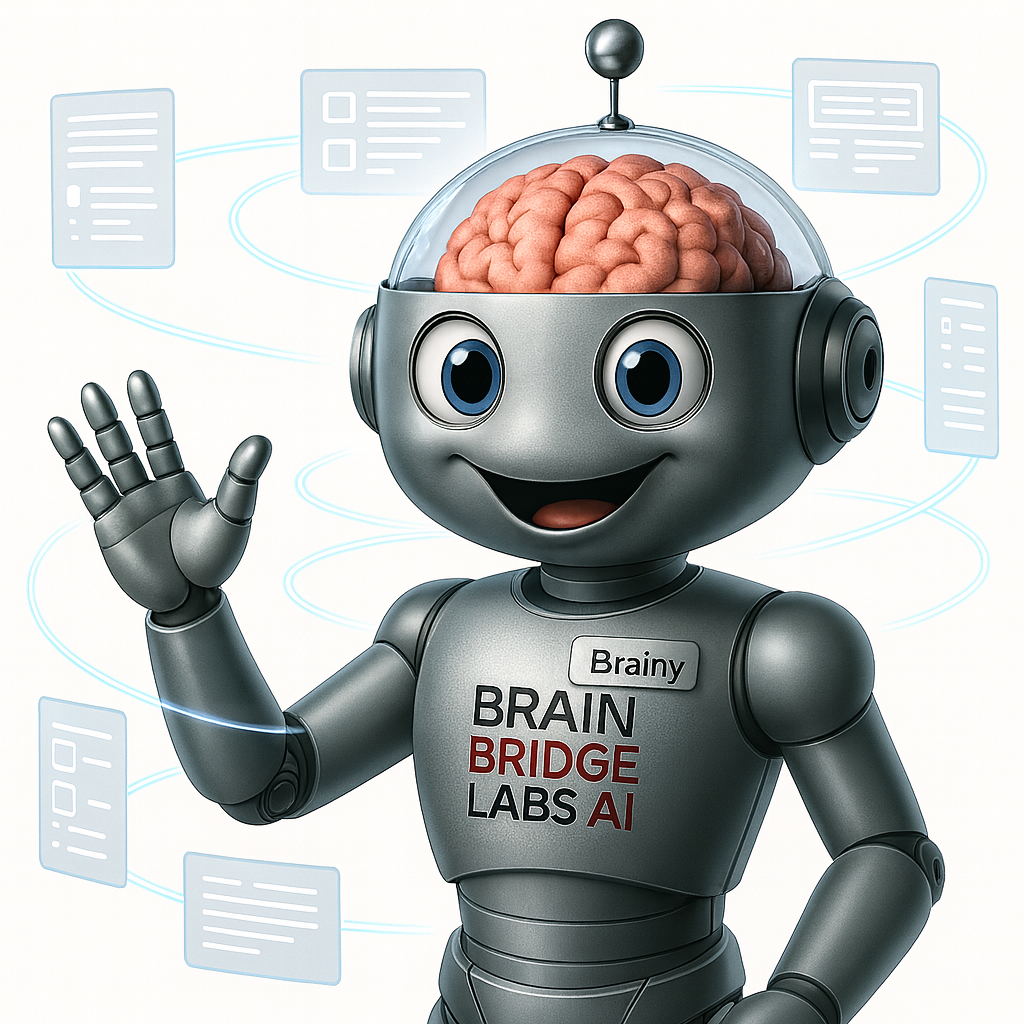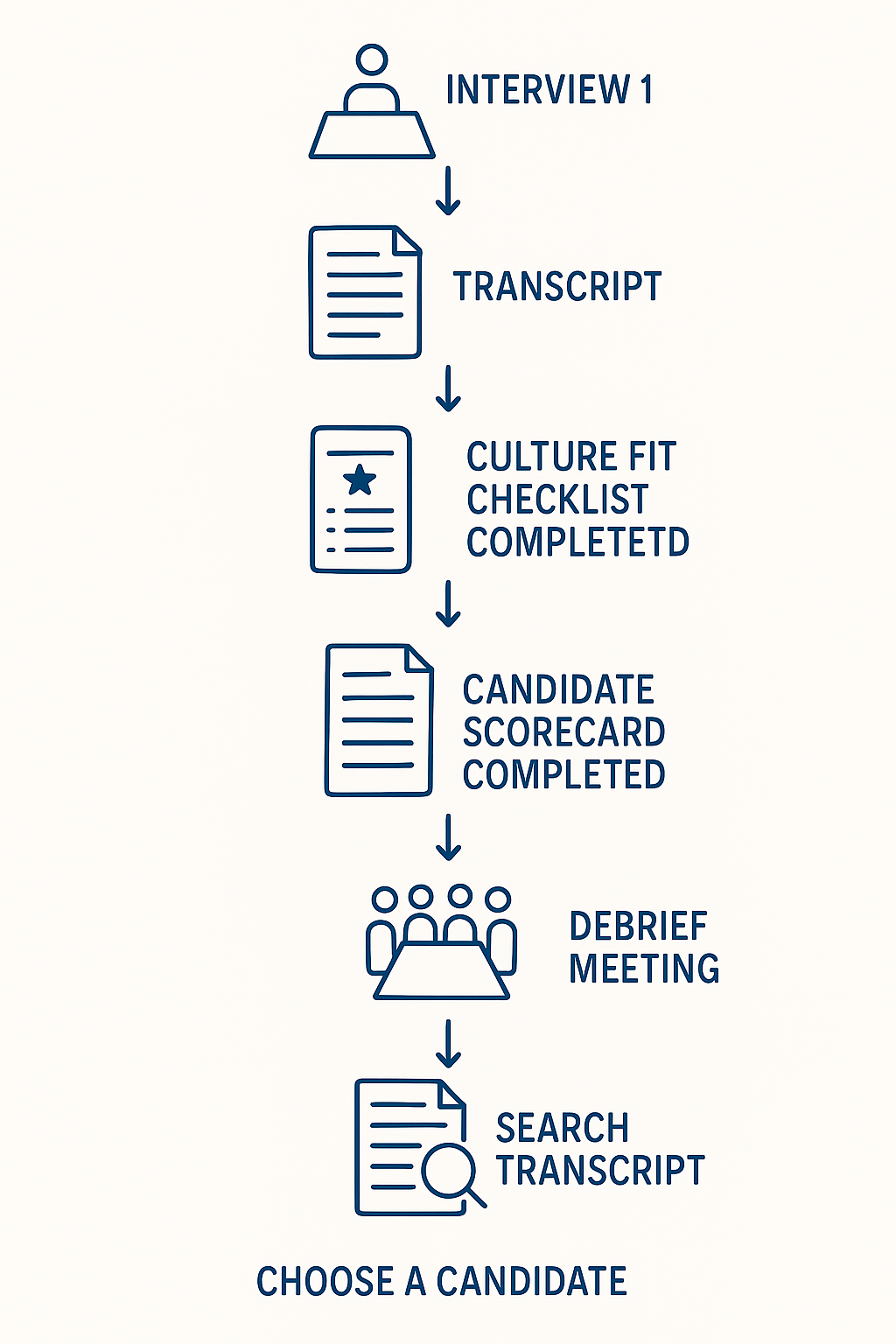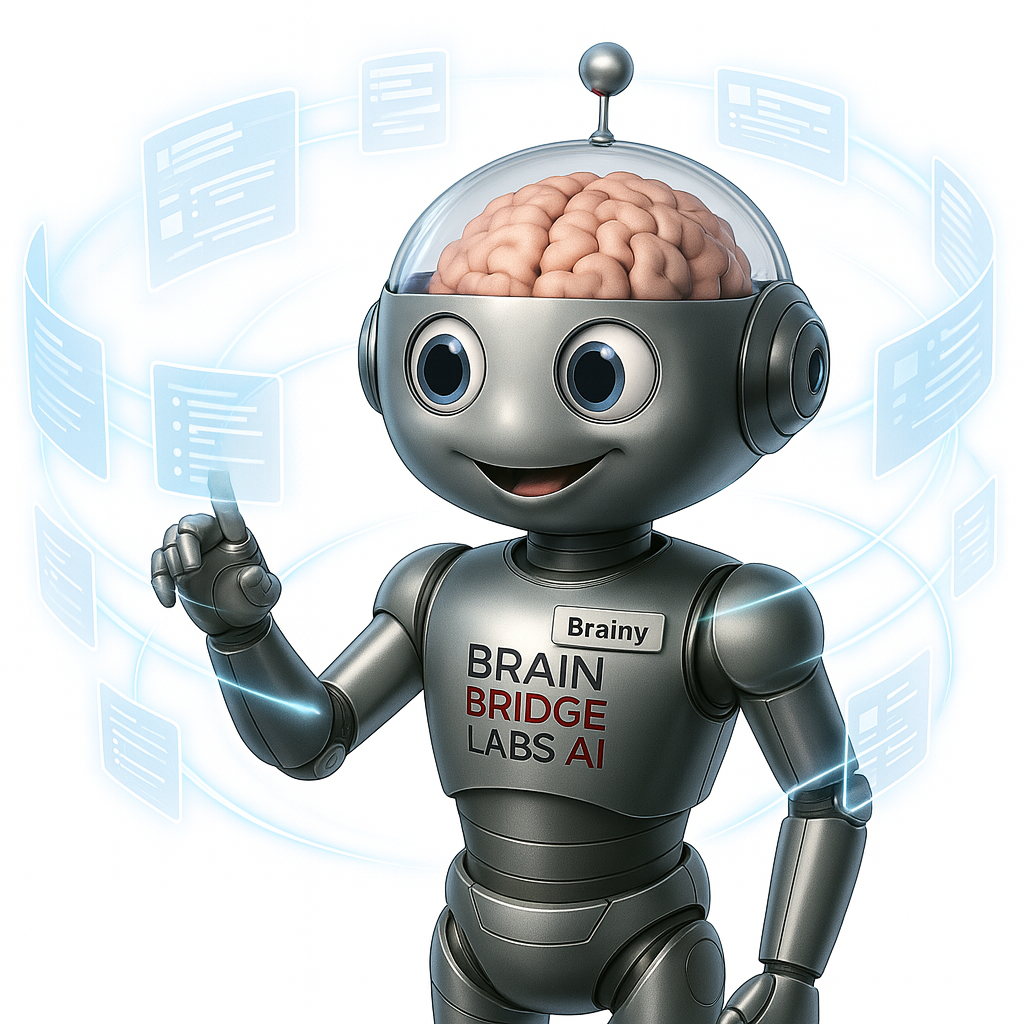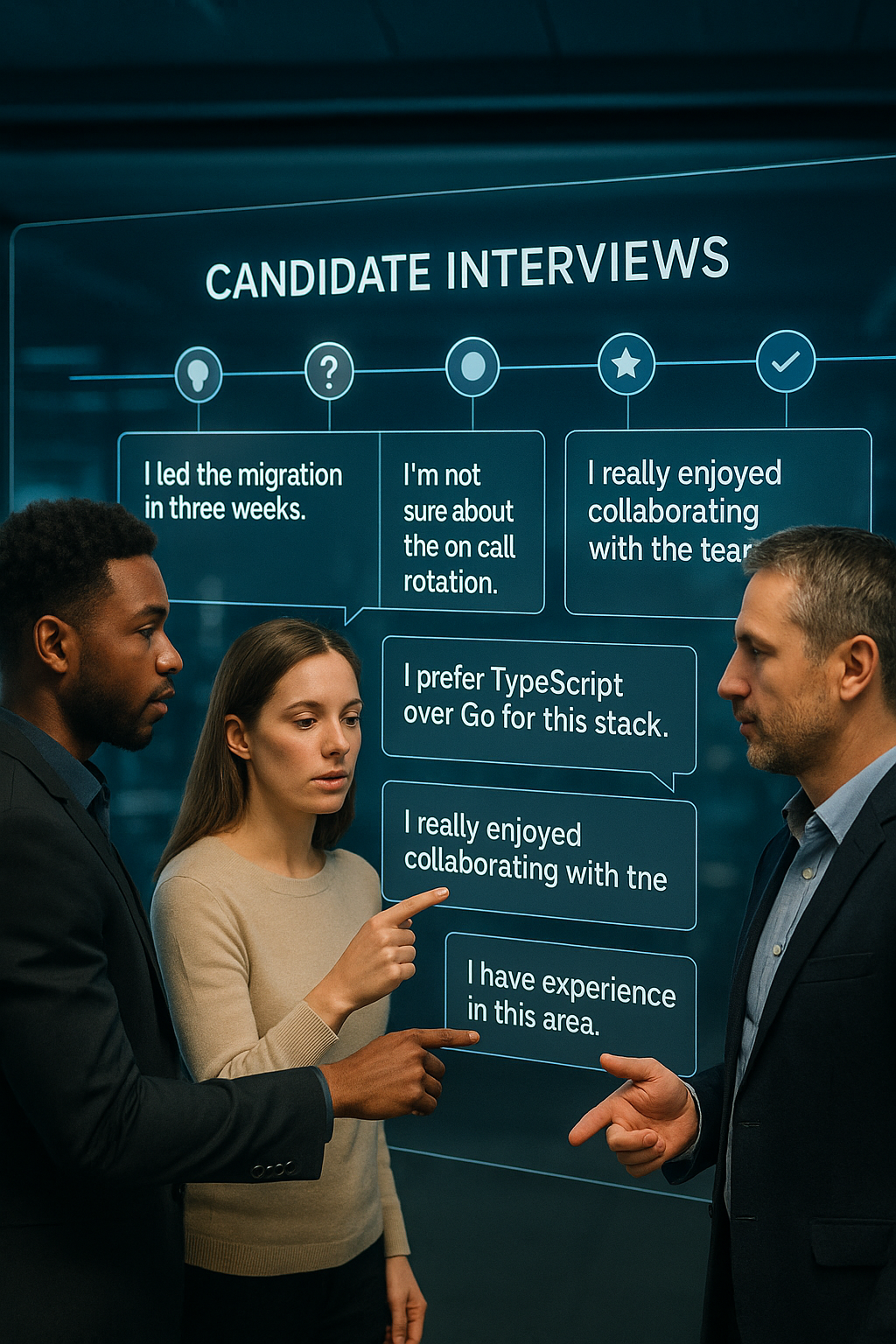INSIGHTS | AI Hiring Strategy
You Can’t Hire the Best, If You Can’t Remember the Interview.
By Josh Brown, Brain Bridge CEO
Published July 15, 2025
TOPLINE
The best candidates aren’t lost because you missed something in their résumé. They’re lost when interview insights aren’t captured, shared, or acted on in a systematic process.
Most hiring teams rely on scattered notes and fuzzy recollections. What they really need is a shared, living memory: one that captures conversations, tags what matters, and turns every interview into clear, actionable signals.
With transcript systems built into your hiring workflow, recruiters and managers can focus on listening, connecting, and evaluating human qualities instead of scribbling notes or relying on gut instinct alone. The result is a better candidate experience, a healthier hiring culture, and more confident decisions.

Bad Hires Aren’t Chosen. Great Hires Are Missed.
In most companies, hiring is often a shared task. HR or the People team runs the process, but department heads and team leads do the interviewing. Feedback comes in bits and pieces with some in Slack, some in email, some in someone’s head.
What looks like a structured hiring process from the outside is usually a patchwork. One person conducts the screen and jots down a few notes. The next interviewer skims the résumé right before the call. A third interviewer joins with no context at all. When the team circles back to make a decision, they’re all operating from different slices of information. This creates a dangerous gap.
A candidate might give a clear example of leadership or adaptability but only one interviewer actually hears it and they hear it through their lense. That insight might be summarized vaguely (“seems like a good culture fit”) or forgotten entirely. By the time the group debriefs, no one has the full picture. Decisions start getting made based on who was the most memorable, not who was the most aligned.
Even worse, the team might default to a “safe” hire with someone who checks boxes on paper but lacks the spark or values fit that showed up in the interview. The standout candidate gets quietly filtered out. Not because they weren’t qualified, but because the evidence that made them great never reached the people who needed to see it.
This isn’t a failure of effort. It’s a failure of memory and a lack of shared visibility across the hiring team. When everyone is working from fragments, hiring becomes more about instinct than insight. That’s when great candidates get missed, and mediocrity makes it through the cracks.
The Right Hire Was There. You Just Forgot Why.
Hiring decisions break down long before the offer. It happens when insights from early interviews fade. When gut instinct overrides actual conversation. When nobody can recall what the candidate said or what they didn’t. A great recruiter doesn’t need more software. They need infrastructure. A Core Memory System that tracks what was said, what stood out, and what still needs to be asked.
That’s what the Brain Bridge Core Memory System delivers. It integrates quietly into the tools you already use—Zoom, Slack, intake calls, panel interviews—and turns scattered conversations into structured, searchable knowledge.
- Strengths and concerns stay visible.
- Gaps don’t get glossed over.
- Debriefs don’t rely on memory they rely on evidence.
No more vague huddles. No more “I think she said something about that.” No more missing out on top talent because nobody wrote down the moment that mattered. This isn’t surveillance. It’s not bureaucracy. It’s how you build a hiring process that’s fairer, faster, and more defensible. One where your team doesn’t just remember the best candidate. They can prove it. The Core Memory System captures the signal in every interview so you can hire with confidence, not hindsight.

Gut Trust Isn’t a Hiring Strategy
When memory runs the process, great candidates slip through.
Hiring mistakes costs far more than the system that prevents it. Brain Bridge helps teams build AI-driven recruiting memory that captures what matters so no insight, red flag, or standout moment gets forgotten. Core Memory tracks every interview, aligns your team, and protects you from costly hiring mistakes. You don’t need to interview more. You need to remember better. We’ll help you do it.
You Don’t Need Another Meeting Transcription Bot. You Need a Hiring Memory.
By now, most hiring teams have tried some kind of AI assistant or note-taker. It joins the Zoom call, records everything, spits out a transcript, and sends it to someone’s inbox where it sits unread or gets buried in the applicant tracking system. It captured words, but not what mattered. No context. No insight. No impact.
What most teams are missing isn’t transcription. It’s memory. A hiring memory is different. It’s not just about recording what happened. It’s about making the conversation useful later, especially for people who weren’t in the room.
A real hiring memory means:
-
Decision makers can pull up exactly what a candidate said about problem-solving, not rely on vague notes.
-
Hiring managers can compare responses across candidates without rereading 20 résumés.
-
Interviewers can tag moments of clarity or confusion as they happen, creating a structured review trail.
-
Leaders can see what influenced the final decision, without chasing people for feedback days later.
It’s not just about convenience. It’s about protecting the integrity of your hiring process when no one has time to debrief in full or write detailed summaries. Most tools today create documentation. You need one that creates alignment. The biggest hiring mistakes don’t come from choosing the wrong person, they come from not remembering the right ones.

A More Human Interview Starts With Less Note-Taking
Most interviews today are split between two competing goals: connect with the candidate and capture what they said. When those goals collide, the quality of both suffers.
Managers juggle scribbled notes, half-formed impressions, and mental checklists while trying to stay present. Candidates pick up on it. Especially, those long pauses, the “sorry, can you repeat that?” moments, the shifting eye contact as the interviewer toggles between listening and typing.
This doesn’t just feel awkward. It creates risk.
-
Strong answers get lost because no one wrote them down.
-
Subtle signals like how a candidate frames a challenge or talks about a team go unnoticed.
-
Follow-ups get skipped because the interviewer is already behind on their notes.
A Core Memory System fixes this in a surprisingly human way. By removing the pressure to capture everything manually, interviewers can stay present. They can follow curiosity instead of checkboxes. They can ask deeper questions, clarify assumptions, and actually hear how someone thinks.
That shift does more than improve the candidate experience. It changes how teams make decisions. The conversation becomes the data, not the person’s memory of it. A more human process isn’t less rigorous. It’s just less mechanical. It frees your team to focus on what actually matters: judgment, connection, and alignment.
Culture Fit Should Be Evaluated, Not Guessed
Everyone says they hire for culture. In reality, when hiring speeds up and schedules are tight, “culture fit” often becomes a vague stand-in for personal chemistry. Feedback starts to sound like:
-
“They seemed like they’d get along with the team.”
-
“Felt like a good fit, just not sure why.”
-
“Something was off, but I can’t put my finger on it.”
This is not a reliable way to build a team. These comments reflect gut instinct, not observable behavior. What often gets labeled as culture fit is actually likability or worse, bias masked as preference.
Evaluating culture fit should mean assessing how a candidate works, communicates, and responds to challenge. It’s about how they talk about ownership, collaboration, accountability, adaptability, and learning. The good news is that these signals show up during interviews. However, they are easy to miss if the interviewer is taking notes, distracted, or reviewing secondhand feedback.
A transcript changes that. It allows the team to go back and find exactly how a candidate described their role on a team, how they handled conflict, or what they valued in a workplace. You can:
-
Highlight statements that show alignment with company values
-
Surface real examples of leadership or humility
-
Spot potential friction points based on how they frame responsibility or feedback
-
Make hiring decisions based on shared language, not individual recollections
This gives your team a consistent lens. One department does not default to hiring “fast movers” while another selects “deep thinkers” unless that distinction is intentional. When culture is evaluated consistently, it can be scaled. That’s how companies maintain their core identity as they grow by building teams around shared, visible behaviors instead of subjective impressions. Culture fit should never be a vibe check. It should be a pattern you can see, name, and trust.

Transcripts Don’t Just Improve Process. They Reinforce Culture.
Most teams see transcripts as a process upgrade. In reality, they are a culture tool. Every interview is more than a checkpoint. It is an expression of what your company values, how it evaluates talent, and what kind of behavior gets rewarded or dismissed.
When interviews are run inconsistently, decisions become inconsistent too. One manager prioritizes collaboration. Another emphasizes autonomy. A third is just trying to fill the seat. Without a shared system for capturing and reviewing what candidates say, each hire reflects the preferences of whoever happened to be in the room.
This drift is subtle, but over time it erodes the culture. Transcripts create alignment. They let teams reflect on the same conversations. They encourage hiring decisions that are grounded in shared criteria, not individual hunches. They make it easier to hold a standard and harder to rationalize exceptions.
This matters especially in companies that are scaling quickly or hiring across multiple teams. HR and People leaders often find themselves playing referee between departments with different hiring instincts. A transcript system reduces that friction. It gives everyone the same source of truth.
Transcripts also help reinforce values over time. When you can revisit what your best hires said during interviews, you start to build a reference library of what “good” sounds like. Those patterns can be used to train new interviewers, refine scorecards, and build stronger hiring rubrics.
Culture does not just come from offsites or values decks. It is defined through decisions. Hiring is one of the most important decisions any company makes. A system that improves the consistency and clarity of those decisions also strengthens the culture behind them.
If One Person Holds the Hiring Context, Everyone’s Guessing
Every interviewer remembers something differentand no one remembers it all.
The best candidates get missed when notes are scattered, scorecards go incomplete, or one decision-maker’s memory drives the hire. Brain Bridge will help you build a shared hiring memory so every conversation, red flag, and signal is captured and searchable before your team makes the wrong call or loses the right person. It’s not just about better hires. It’s about alignment, speed, and margin protection.

Debriefs Should Not Feel Like a Memory Test
Too often, hiring debriefs feel like a game of telephone. One interviewer recalls a strong answer about leadership. Another isn’t sure that question was even asked. A third remembers a great story but can’t explain why it stood out. Everyone is working from partial memory, vague notes, or secondhand impressions.
This is not just inefficient. It’s risky. When decisions are based on fuzzy recollections, strong candidates get overlooked, mediocre ones get a pass, and no one feels fully confident in the outcome. It also reinforces bias. Whoever speaks first often sets the tone, and quiet disagreement gets buried under louder conviction.
Transcripts eliminate the ambiguity. With a searchable record, the team can:
-
Pull up specific quotes tied to scorecard criteria
-
Verify details rather than debate them
-
Spend time discussing meaning, not memory
Instead of wondering what was said, your team can focus on what it meant and whether it aligns with what the role and company actually need. Hiring should never be reduced to who remembered best. It should be about who fits best. Transcripts give your team the clarity to make that call.
The ROI of Systemized Hiring Is Bigger Than You Think
Bad hires do more than waste time. They create drag across your entire organization by chipping away at productivity, morale, and ultimately, the bottom line.
In most companies, the true cost of a hiring misfire is scattered across several areas:
-
Wasted compensation in salary, benefits, and ramp-up costs, often totaling $10,000 to $50,000 before a departure is finalized
-
Lost productivity when managers are forced to cover gaps or redo work
-
Delays in delivery or revenue caused by mismatched hires slowing down key initiatives
-
Team friction and morale dips that lead to secondary turnover
-
Restarting the hiring process from scratch, with additional recruiting, screening, and onboarding costs
Even an “okay” hire, the kind that never causes a major issue but never truly contributes has a cost. They consume training time, occupy headcount, and dilute team performance over time. These costs rarely show up on a balance sheet, yet they eat into margin and growth capacity with every passing week.
On the flip side, strong hires pay dividends quickly:
-
Onboarding goes faster because the person aligns with the team and role
-
Training time is better spent because the hire already thinks the way the business operates
-
Teams perform better when they trust and rely on each other
-
Retention improves because the employee feels connected and capable early on
Hiring may feel like a “people problem,” but it is absolutely a financial decision. A systematic process with shared insight, consistent criteria, and searchable records protects against silent failure. It creates real business leverage. Perfect hiring is not the goal. Reducing risk and increasing confidence is. A single great hire compounds value. A single bad one creates drag across your entire system.
Final Word: Human Memory Isn’t A Purchasing Process. You Have To Build One.
Every great team begins with a series of decisions: who to hire, why they were chosen, and how they align with the company’s goals.
When those decisions rely on memory alone, consistency disappears. The best candidates can be forgotten, hiring mistakes become harder to detect, and cultural drift sets in. Over time, these small breakdowns erode team performance and trust. Transcripts change the dynamic by providing a record of what was said, what stood out, and how decisions were made. Everyone involved in hiring can access the same context and review the same conversation, regardless of whether they were in the interview or not.
This is not about creating red tape. It is about creating clarity. When teams use transcripts, they spend less time guessing and more time building alignment. Hiring becomes faster, onboarding becomes smoother, and retention improves because the match is real. There is no need to add more meetings or more tools that slow people down. What companies need is a system that listens, captures what matters, and supports better judgment at every step of the process.
That is how strong teams are buil and how they stay strong as the company grows.

